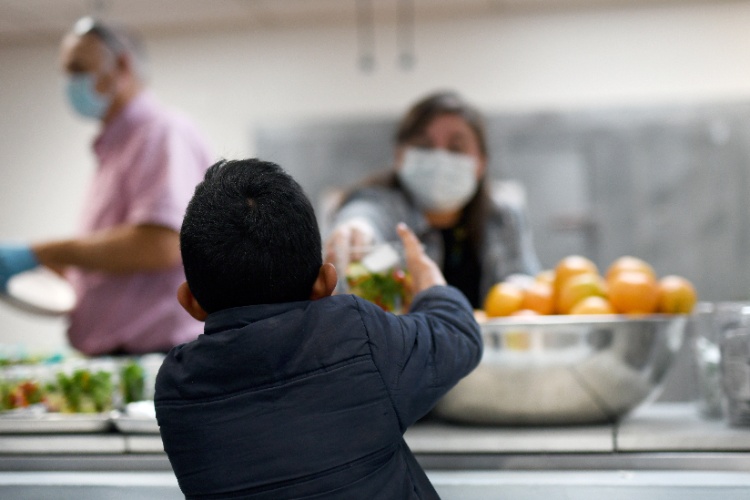Across the United States, food insecurity is rising, and many low-income families, including refugees, asylees, and other Office of Refugee Resettlement (ORR)-eligible populations, are finding it harder to keep nutritious food on the table. According to the U.S. Department of Agriculture, in 2023, nearly 47 million people, including 7.2 million children, lived in households that faced uncertainty about where their next meal would come from. In July 2025, H.R.1 revised eligibility rules for the Supplemental Nutrition Assistance Program (SNAP). Certain humanitarian populations, including refugees, asylees, and survivors of trafficking or domestic violence who hold T or U visas, are no longer eligible. Upon adjusting status, clients may be subject to a five-year waiting period. Please check with your state office as they adapt eligibility guidelines to meet these requirements.
Changes in federal and state funding have also affected the range of programs that support food access, such as the Local Food Purchase Assistance Program, the Emergency Food and Shelter Program, Community Development Block Grants, and The Emergency Food Assistance Program (TEFAP). During this critical time, service providers play a vital role in connecting clients to food resources. This post shares available supports in your city, in your state, and at the federal level.
At the Federal Level
- Keep eligible clients (for example, Cuban and Haitian Entrants) enrolled in the Supplemental Nutrition Assistance Program (SNAP), and leverage the Double Up Food Bucks where possible. SNAP provides food benefits to low-income families to supplement their grocery budget so they can afford the nutritious food essential to health and well-being. Able Bodied Adults Without Dependents (ABAWD) will need to fulfill their volunteer/work hours to continue qualifying for SNAP.
- ORR-eligible newcomers remain eligible for WIC (Special Supplemental Nutrition Program for Women, Infants, and Children). WIC provides monthly nutrition benefits for specific foods (such as milk, cereal, eggs, baby formula, etc.), along with nutrition education and health referrals, to low-income pregnant women, postpartum and breastfeeding mothers, infants, and children under age 5. Those enrolled in WIC are also eligible to use WIC Farmers Market Nutrition Program (FMNP) vouchers at participating farmers markets.
- Seniors age 60 or older, with household income at or below 185% of the Federal Poverty Guidelines qualify for the Senior Farmers Market Nutrition Program, which provides vouchers for use at farmers markets in participating states.
- Make sure clients are enrolled in cash assistance programs like Temporary Assistance for Needy Families (TANF), Refugee Cash Assistance (RCA), or Supplemental Security Income (SSI). TANF provides cash assistance to low-income families with children, while RCA is reserved for single adults and childless couples. SSI provides monthly cash assistance to low-income people who are elderly (65+), blind, or disabled. Cash benefits can be used to pay for essentials like food, housing, utilities, clothing, and other basic needs.
- Some Preferred Communities (PC) programs may be able to provide “direct financial assistance for emergency needs” for eligible clients, which includes emergency food assistance.
- ORR Policy Letter 24-03 clarifies that Refugee Support Services (RSS) funds may be used, when necessary, to provide “assistance with meeting the nutritional needs of ORR-eligible individuals in the short-term,” when food insecurity is identified. “A State or Replacement Designee that identifies the need to use RSS base funds for food assistance does not need to submit a written request to use RSS base funds for this purpose. It can simply notify its DRA Regional Representative/Analyst, with copy to DRA, of its intent, with confirmation that food assistance will be provided on a short-term basis.” Local RSS providers should check with their State Refugee Coordinator (SRC) to confirm whether this flexibility is currently being implemented in their state and to understand any state-specific guidance or procedures that may apply.
- You can call the Switchboard Community Support Line, 9 AM – 5 PM ET, Monday – Friday, at (212) 551-3100 to explore a possible referral to local PC or RSS providers.
- Know that ORR-eligible newcomers remain eligible for School Lunch and School Breakfast Programs. These federal programs provide free or reduced-price meals at school to children from low-income households during the academic year. All ORR-eligible children can still benefit from these meals if they meet the income criteria. Some states offer universal school meals by supplementing with state funds (see below).
- ORR-eligible children remain eligible for the SUN Bucks Program. The Summer EBT benefit provides grocery money for families with school-aged children to help cover food costs in the summer. Each eligible child receives $120 total in food benefits when school is out (often issued as $40 per month of summer). Children are automatically enrolled if their household already receives income-based benefits like SNAP or TANF, or if the child was approved for free- or reduced-price school meals.
- ORR-eligible children can also access the Summer Food Service Program (SFSP), which offers free meals to children during summer break when school is out. All children and teens age 18 or under qualify, with no income limit and no application required.
- ORR-eligible seniors remain eligible for the Commodity Supplemental Food Program (CSFP). CSFP is a nutrition program specifically aimed at low-income seniors. It provides a monthly box of USDA food (a package of staple groceries such as cereal, canned foods, juice, milk, cheese, etc.) to eligible individuals age 60 or over.
In Your State
The chart below lists states that fund their own supplemental food assistance programs:
In Your City and County
- Reach out to WhyHunger or the Hunger Hotline to identify other local emergency food resources (e.g., food pantries, soup kitchens, summer meal sites, grassroots organizations, etc.)
- Call your local human service department or other appropriate department to inquire if they will be providing additional services and support to help mitigate the impact of federal policy changes.
- Explore if there is a local food security coalition that your organization can join to stay up to date on local efforts. The Alliance to End Hunger has a helpful search tool to find these partners.
- Search for your local foodbanks here. The U.S. Department of Agriculture (USDA) provides food to food banks through programs like The Emergency Food Assistance Program (TEFAP), while some states supplement further with state funds.
Beyond Referrals: Four Ideas for Expanding Food Security Supports
- Coordinate regular food distributions for clients. Connect with emergency food assistance organizations or food “gleaning” groups, which “rescue” unsold food from being discarded, to host a regular food distribution or pantry at your local office or at other local schools, gardens, or ethnic community-based organizations (ECBOs) that are accessible to clients.
- Work with local farming programs to source food for community food distributions. Many sites host harvest giveaways at gardens. Other programs around the country have set up “sliding scale” harvest subscription programs, where higher-income buyers subsidize food boxes made available to lower-income families, while the farmer still gets paid a fair price.
- Organize tours and orientations to local food access points, such as food pantries, food rescue organizations, and other community food box distribution points. Clients sometimes need help in understanding how these entities operate, whether they are eligible, and what food is available, and may have discomfort with language, stigma, or other cultural barriers. Ensure that you are clear about eligibility criteria and what clients can expect when they arrive (food selection, language resources, anything they need to bring, etc.).
- Offer nutrition and food navigation orientations or classes. Consider providing workshops on how to eat healthy on a budget (see Switchboard’s Eating Healthy Guide for Newcomers Curriculum) or building out your nutrition education programs to ensure all clients understand how to access and use the benefits and food access points that can help them.
Takeaway
Food insecurity will continue to shift with economic and policy changes, but reliable local systems and informed providers can help buffer their impacts. By building strong connections across food networks and regularly updating your knowledge of available programs, you can help create more dependable pathways to food access. In doing so, you help ensure that families, especially newcomers, can meet their most basic need: consistent, healthy meals.
Learn More
- Blog Post: Six Key Findings About New Americans and Food Insecurity
- Blog Post: Three Steps You Can Take to Support Clients’ Food Security
- Podcast: A Path to Food Security & Nutrition for Refugees & Immigrants in the U.S: Building an Evidence Base
- Guide: Agricultural Program Development for Newcomers in the U.S.
The IRC received competitive funding through the U.S. Department of Health and Human Services, Administration for Children and Families, Grant #90RB0053. The project is 100% financed by federal funds. The contents of this document are solely the responsibility of the authors and do not necessarily represent the official views of the U.S. Department of Health and Human Services, Administration for Children and Families.









